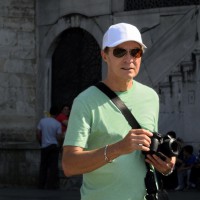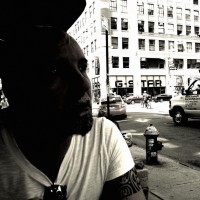by M. Kobal
This shot was taken in the Vremscica ridge area in southern Slovenia, just a short distance from the Karst region. This might be one of the last photographs of a windswept landscape that may soon change radically.
Canon 30D . Canon 10-22mmf/3.5 . 10mmmm . 36ss . f/3.5 . ISO160
"La Résistance" is the title of my series of nature photographs of subjects that fight for their existence with everything they have. This is French for "The Resistance," and I chose this title to associate the photo with the powerful will to fight for freedom as shown by the French partisan resistance during World War II.Vremscica is a special ridge that is constantly being hit by the winds coming from the sea and the Karst. There is also a secret plan to build wind turbines up there, so I wanted to photograph it before it changed. Another reason to visit was for the special trees growing there. Because of the constant wind, their shape deviates from a normal vertical growth to a semi-horizontal form. There are not many of them, and even though they seem big in the photograph, they are actually quite small, which makes them even harder to find. I did manage to find the most beautiful one, in my opinion, and it was just inviting me to photograph it. The tree instantly made its way into my "La Résistance" concept.
"The wind was vicious and the temperature dropped well below zero, but I was so determined that it didn't stop me."
I decided to shoot after dark because of the beautiful winter night, the snow and the half moon shining brightly in the sky. I reached the top of the ridge after climbing for an hour. The wind was vicious and the temperature dropped well below zero, but I was so determined that it didn't stop me. The only gear I brought with me was my Canon DSLR, a wide-angle zoom lens and an aluminum tripod. I had to support the tripod with stones; it would not stop vibrating because the wind was so strong. The camera needed to be really stable since I was doing a long exposure. The lens, set to a focal length of 10 mm, was wide enough to capture the tree and a fair amount of the surrounding landscape. The tree looks much bigger than it actually is thanks to the wide angle. To achieve this effect, you must get as close to your subject as possible.Since it was a half moon night and the sky was almost clear, there was a significant amount of light coming from the moon, which made a perfect shadow to the right of the tree and also lit the clouds and landscape. Snow on the ridge is another important factor in the success of the shot: it isolates the main subject, the tree, improves contrast in the shadows, and gives the story another dimension.
"I mounted the camera on the tripod about three feet (one meter) above the ground to make the tree look bigger and to be able to include more of the sky."
I positioned myself to find the best angle of the tree and to include the shadow. I mounted the camera on the tripod about three feet (one meter) above the ground to make the tree look bigger and to be able to include more of the sky. I used a wired remote trigger and the camera's bulb mode so I could manually control the exposure time. Because of the bright moonlight 36 seconds was enough. The weather conditions were severe with strong, cold winds and low temperatures. I had put a spare battery in my sock to keep it warm since battery performance quickly degrades in cold conditions. I was surprised by the longevity of the battery; I didn't even have to swap it after two hours of shooting! My most important tip is to wake up early or to go to sleep late: these are the times when you usually capture the most beautiful landscape images and there’s less likelihood of people in your photos.
I used Lightroom 2 and Photoshop to edit the photo, which was shot in RAW format. I prefer Lightroom instead of Adobe Camera Raw because of the user-friendly interface.
1) In Lightroom I corrected the Exposure, Highlights and Shadows, always checking the histogram to make sure I had a wide dynamic range without any clipping.
2) When I was satisfied with the Contrast, I adjusted the White Balance.
3) Then I adjusted the colors to reduce a blue color cast in the snow and sky and a yellow color cast in the clouds from the light pollution of a distant town.
4) The Contrast was tweaked using the Tone Curve, giving me greater control than the Contrast slider. I then exported the image to Photoshop.
5) In Photoshop I applied the High Pass filter to sharpen the image. I also reduced the blue tone in the snow even more. The goal was to achieve, through post-production, what my eyes saw at the time, and I came quite close.
I am a freelance photographer based in Ljubljana, Slovenia. I was born in 1981 and I studied Japanese and philosophy. I have lived in Japan and this has had a significant impact on me. I've been an international DJ for over 10 years and I started photography in my mid-20s. My favorite types of photography are portrait, street, architecture, industrial and landscape.













